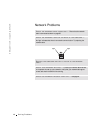
50 Solving Problems
www.jp.dell.com | support.jp.dell.com
IF THE POWER LIGHT IS OFF — The computer is either turned off or is not
receiving power.
• Ensure that the power cable is firmly inserted into both the power connector
on the back of the computer and the electrical outlet.
• If the computer is plugged into a power strip, ensure that the power strip is
plugged into an electrical outlet and that the power strip is turned on.
• Ensure that the electrical outlet is working by testing it with another device,
such as a lamp.
• Ensure that the voltage selection switch is set to match the AC power at your
location (see page 9).
• Bypass power protection devices, power strips, and power extension cables to
verify that the computer turns on.
• Swap the computer and monitor power cables to determine if the power cable
is defective.
• Ensure that the microprocessor power cable is securely connected to the
system board (see page 77).
• Ensure that the power supply cables are securely connected to the system
board (see page 77).
• If the problem persists, contact Dell (see page 95).
IF THE POWER LIGHT IS STEADY AMBER — The computer is receiving
electrical power, but an internal power problem might exist.
• Ensure that the power cable is firmly inserted into both the power connector
on the back of the computer and the electrical outlet.
• Ensure that the voltage selection switch is set to match the AC power at your
location (see page 9).
• Ensure that the microprocessor power cable is securely connected to the
system board (see page 77).
• Ensure that the power supply cables are securely connected to the system
board (see page 77).
• If the problem persists, contact Dell (see page 95).
IF THE POWER LIGHT IS BLINKING AMBER — A device might be
malfunctioning or incorrectly installed.
• Remove and then reinstall the memory modules (see page 82).
• Remove and then reinstall any cards (see page 80).
• Remove and then reinstall the video card, if applicable (see page 82).
• If the problem persists, contact Dell (see page 95).


















